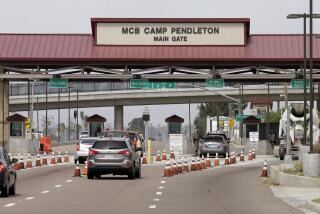Haditha killings detailed at hearing
- Share via
CAMP PENDLETON — Some of the 24 Iraqis killed by Marines in Haditha in late 2005 were shot in the head, several of them at such close range that the bodies had powder burns, a prosecutor said Thursday.
As a hush came over the courtroom, Lt. Col. Paul Atterbury listed some of the victims, including an unarmed 66-year-old woman, a young woman shot while sitting with her back to a wall, a teenage girl shot while on a bed, an elderly man whose leg was severed by a grenade and a woman killed while trying in vain to protect several small children.
Atterbury added that five young men killed near their car apparently were standing still, possibly with their hands in the air to surrender.
No weapons were found in the car or near the men’s bodies, Atterbury said. Nor were any weapons found in the three homes where members of three families were killed as Marines “cleared” the houses with fragmentation grenades and M-16 fire, according to a Marine lieutenant who inspected the houses and removed the bodies.
The testimony came on the second day of an Article 32 inquiry, similar to a preliminary hearing, for Lt. Col. Jeffrey Chessani, 43. He is accused of dereliction of duty and failure to follow an order for not launching an investigation of the Nov. 19, 2005, incident in which Marines in his battalion killed 24 Iraqis, including three women, seven children and several elderly men.
After the grisly recitation, Atterbury asked a Defense Department lawyer considered an expert in the laws involving war crimes whether the facts surrounding the deaths should have been sufficient for the battalion commander to call for an outside investigation.
“To me, it’s quite clear,” said W. Hays Parks, one of the key authors of the military’s rules requiring commanders to report any “possible, alleged or suspected” crime by their troops. He said that such rules were adopted after the My Lai massacre in Vietnam, in which commanders made only cursory inquiries in the days after the mass killing.
“The idea is to encourage the commander to continue the battle but turn over incidents to competent investigators rather than doing it themselves,” Parks said.
Prosecutors say Chessani made only a superficial inquiry after the killings, accepting at face value the assertion by enlisted personnel that the Iraqis were killed while the Marines were clearing houses from which insurgents had been firing at them.
But defense attorneys have said Chessani, who was commander of the 3rd Battalion, 1st Marine Regiment, told superiors that women and children had been killed and that his superiors failed to launch an investigation.
Brian Rooney, one of Chessani’s lawyers, said the defense disagreed with the prosecution’s characterization of how the Iraqis were killed. He said that no autopsies were performed and that prosecutors were interpreting photographs of the bodies taken by military personnel.
Chessani is the highest-ranking officer charged in what is the largest war-crime allegation involving U.S. troops in Iraq or Afghanistan. Three other officers and four enlisted Marines also have been charged in the case.
*
More to Read
Sign up for Essential California
The most important California stories and recommendations in your inbox every morning.
You may occasionally receive promotional content from the Los Angeles Times.













